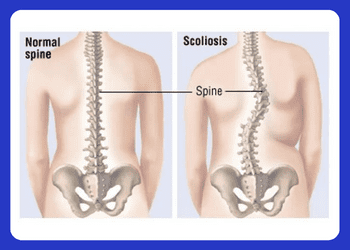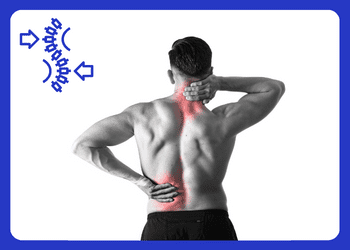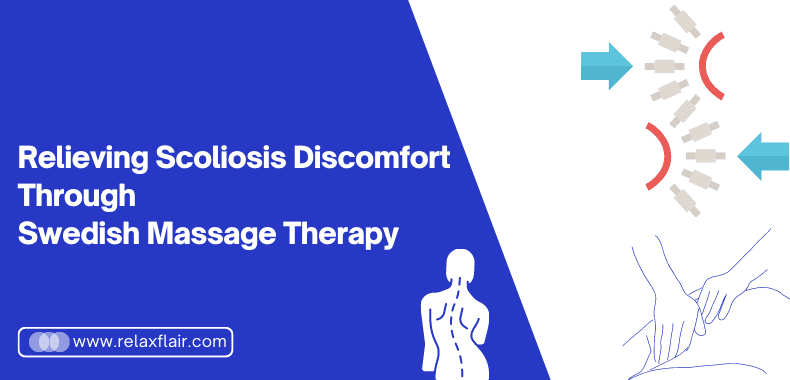Scoliosis is a medical condition that causes a sideways curvature of the spine, which can lead to discomfort, pain, and even disability. It affects people of all ages, but most commonly occurs in children and adolescents. In this article, we will explore the natural approach of Swedish massage as a means of pain relief for those suffering from scoliosis.
Scoliosis is a common condition, affecting an estimated 2-3% of people worldwide. Women are more likely to be affected than men, and the cause is often unknown; however, it can potentially result from genetic factors or related medical conditions such as cerebral palsy, muscular dystrophy, or spinal muscular atrophy.
Properly diagnosing the root of scoliosis is essential for successful treatment and management, as it can often arise from poor posture, spinal trauma, or degenerative diseases.
Massage techniques can be helpful for back pain and scoliosis by reducing tension and promoting relaxation in the affected muscles. Swedish massage, deep tissue massage, and myofascial release are some of the commonly used techniques to alleviate pain and improve the range of motion in the back. It is important to consult with a licensed massage therapist who can tailor the massage session to the individual needs and conditions of the client.
What is Scoliosis?
Scoliosis is a medical condition characterized by an abnormal curvature of the spine. Instead of the spine appearing straight, it curves sideways, forming an “S” or “C” shape. This curvature can occur at any point along the spine and can range from mild to severe.
 The most common form of scoliosis is idiopathic scoliosis, which means that the cause is unknown. However, it’s believed to be a combination of genetic and environmental factors. Other forms of scoliosis can be caused by conditions such as cerebral palsy, muscular dystrophy, and spinal muscular atrophy.
The most common form of scoliosis is idiopathic scoliosis, which means that the cause is unknown. However, it’s believed to be a combination of genetic and environmental factors. Other forms of scoliosis can be caused by conditions such as cerebral palsy, muscular dystrophy, and spinal muscular atrophy.
Scoliosis can affect people of all ages, but it typically develops during childhood and adolescence. It’s more common in females than males, and the curvature tends to worsen during growth spurts.
Scoliosis can lead to a range of symptoms, including back pain, uneven shoulders or hips, and breathing difficulties. In severe cases, scoliosis can cause compression of the lungs and other organs, leading to serious health complications.
While there is no known cure for scoliosis, there are various treatment options available to manage the symptoms and prevent the curvature from worsening. One of these options is Swedish massage, a natural approach to pain relief that can provide numerous benefits to those with scoliosis.
What Type of Massage is Good for Scoliosis?
Indulge in a Swedish massage to benefit someone with scoliosis; this renowned technique involves kneading, long strokes, and circular motions on the topmost layer of muscles to relax the tension and alleviate pain. Deep tissue massage and myofascial release techniques may also be beneficial for managing any associated discomfort from scoliosis. Massage therapy can be an effective form of treatment for scoliosis, provided it is utilized in tandem with other forms of care. To ensure the best results, seek out a certified massage therapist who not only has experience treating this condition but also knows how to target and release deeper layers of muscle and connective tissue tension as well as break down adhesions.
The Benefits of Swedish Massage for Scoliosis Pain Relief
Swedish massage is a popular massage technique that involves long, smooth strokes, kneading, and circular movements on the topmost layer of muscles. This technique has been shown to be effective in relieving scoliosis pain and improving overall well-being. Some benefits of Swedish massage for scoliosis pain relief include:
- Improved circulation: Swedish massage can help improve blood flow, which can relieve tension and promote healing in affected areas of the body.
- Reduced muscle tension: Tight muscles can exacerbate scoliosis pain, but Swedish massage can help loosen and relax these muscles, reducing tension and discomfort.
- Improved range of motion: It can help increase flexibility and range of motion in the affected area, which can reduce pain and improve mobility.
- Enhanced relaxation: Scoliosis pain can be stressful and exhausting, but Swedish massage can help promote relaxation and reduce stress levels.
 Swedish massage can be performed by a massage therapist or using a massage chair. In a massage chair, the Swedish massage technique can be programmed to target specific areas of the back affected by scoliosis. This can be especially helpful for individuals who cannot tolerate the pressure of manual massage or prefer the convenience of at-home massage.
Swedish massage can be performed by a massage therapist or using a massage chair. In a massage chair, the Swedish massage technique can be programmed to target specific areas of the back affected by scoliosis. This can be especially helpful for individuals who cannot tolerate the pressure of manual massage or prefer the convenience of at-home massage.
Swedish Massage Techniques for Scoliosis Pain Relief
- Effleurage: Indulge in the healing power of effleurage, a Swedish massage technique that involves long and gentle gliding strokes with either your hands or fingers. This method is often used as the perfect prelude to deeper massage work because it helps increase blood circulation, reduce tension in muscles, and induce an overall feeling of relaxation.
- Petrissage: Give your muscles a break and get improved blood flow with Petrissage, a massage technique from Sweden. Involving kneading and rolling motions of the hands, fingers, or thumbs, this powerful method can help to reduce tightness in tired muscles while being combined with effleurage for optimal results.
- Tapotement: Swedish massage therapy utilizes a special technique termed tapotement which consists of tapping, pounding or slapping movements performed rhythmically with the hands and fingers. The primary objectives are to animate the muscles, enhance circulation and ultimately achieve relaxation.
- Friction: Put your worries at ease with Swedish massage techniques like Friction, which involve pressing and rubbing movements by the practitioner’s hands or fingers. Not only will it help to relieve muscle tension, but also improve circulation in certain body parts that need a deeper tissue massage. It is an efficient way of bringing long-lasting relief from tight muscles.
Precautions and Contraindications for Swedish Massage for Scoliosis Pain Relief
Swedish massage provides a safe and beneficial experience for most people, including those with scoliosis. Nevertheless, qualified massage therapists must be aware of certain precautions and contraindications to guarantee their clients’ safety as well as serenity during the treatment.
Precautions
- Prior to commencing any massage therapy, it is critical to consult with the client’s physician or healthcare provider.
- The massage therapist should have an intimate knowledge of the client’s medical history, including any surgeries, injuries and/or chronic issues.
- Throughout the massage session, the therapist should continually stay in dialogue with their client and adjust their techniques based on feedback.
- It is best for the massage therapist to abstain from kneading on any areas of soreness, inflammation, or discomfort in and around the spine.
- The massage therapist should abstain from using intense or deep pressure techniques that could potentially worsen any existing conditions.
Contraindications
- Massage therapy should not be used as a substitute for medical treatment or advice.
- Massage therapy is contraindicated for individuals who are suffering from acute injuries, infections, or fever.
- Massage therapy should be avoided for clients with open wounds, skin infections, or rashes.
- Those with progressive osteoporosis or any degenerative bone disorder should abstain from vigorous massage techniques and intense pressure.
- Clients with severe scoliosis may require specialized treatment and should consult with their healthcare provider before starting massage therapy.
Swedish massage is a reliable and powerful way to manage the pain and discomforts of scoliosis. However, it’s essential for therapists to be mindful of any contraindications and implement safety measures before beginning each session in order to maximize their clients’ overall health and well-being.
Frequently Asked Questions
What are Some Common Causes of Scoliosis?
Scoliosis can develop at any age and affects both sexes equally. In most cases, the cause of scoliosis is unknown, referred to as idiopathic scoliosis. However, several factors can contribute to scoliosis, including congenital disabilities, neuromuscular conditions such as cerebral palsy, muscular dystrophy, and spina bifida, and connective tissue disorders such as Marfan syndrome. Other potential causes include traumatic injuries, infections, and tumors. Early diagnosis and treatment of scoliosis can help prevent the condition from worsening.
What Are the Different Types of Scoliosis?
There are four primary types of scoliosis, congenital scoliosis, neuromuscular scoliosis, degenerative scoliosis, and idiopathic scoliosis. Congenital scoliosis occurs due to spinal malformation during fetal development. Neuromuscular scoliosis occurs due to abnormal neuromuscular conditions such as cerebral palsy, muscular dystrophy, and spinal muscular atrophy. Degenerative scoliosis is associated with the aging and degeneration of spinal discs and joints. Idiopathic scoliosis, which is the most common type, has no apparent cause.
Can Massage Therapy Cure Scoliosis?
Unfortunately, massage therapy cannot cure scoliosis. However, it can help alleviate some of the symptoms associated with scolioses, such as muscle tension and pain. Swedish massage, in particular, is an effective approach to pain relief, as it focuses on reducing muscle tension and promoting relaxation. Additionally, regular massage therapy can help improve range of motion and flexibility in the affected areas, making it easier to perform everyday activities.
How Often Should I Receive Massage Therapy for Scoliosis?
The frequency of massage therapy for scoliosis varies depending on individual needs and symptoms. Generally, it’s recommended to receive a Swedish massage once or twice a week initially, and then the frequency can be decreased as symptoms improve. However, it’s essential to work with a licensed massage therapist who can assess your specific needs and develop a treatment plan that works for you.
Are There Any Risks to Getting a Massage if I Have Scoliosis?
Generally, massage therapy is considered safe for individuals with scoliosis. However, there are a few precautions to consider, especially if you have severe scoliosis. In some cases, deep tissue massage or trigger point therapy can worsen pain and discomfort. Therefore, it’s crucial to work with a licensed massage therapist who has experience working with individuals with scoliosis and can tailor the massage technique to your specific needs. It’s also essential to inform your massage therapist about your medical history and any current treatments you’re undergoing.
Is Swedish Massage Good for Scoliosis?
Swedish massage is a popular technique that involves long, flowing strokes, kneading, deep circular movements, vibration, and tapping. The primary goals are to relax the entire body, improve circulation, and increase flexibility. The technique can be customized to address specific areas of tension and discomfort, making it a versatile choice for various conditions, including scoliosis.
Benefits for Scoliosis
Muscle Relaxation: Scoliosis often causes muscle imbalances, with some muscles becoming overactive and tight while others weaken. Swedish massage can help relax tense muscles, reducing pain and improving overall comfort. Techniques like effleurage (long, gliding strokes) and petrissage (kneading) can alleviate muscle tightness and spasms commonly associated with scoliosis.
Improved Circulation: Enhanced blood flow from massage can aid in the delivery of nutrients and oxygen to affected areas. This can promote healing and reduce inflammation, potentially easing some of the discomfort linked to scoliosis.
Pain Relief: The soothing nature of Swedish massage can stimulate the release of endorphins, the body’s natural painkillers. This can provide temporary relief from the chronic pain often experienced by individuals with scoliosis.
Enhanced Mobility: Regular massage therapy can improve the flexibility of muscles and joints. For scoliosis patients, this can mean better range of motion and reduced stiffness, contributing to improved overall mobility and function.
Limitations and Considerations
While Swedish massage offers several benefits, it is important to acknowledge its limitations. Swedish massage cannot correct the spinal curvature of scoliosis. It is a supportive therapy, best used in conjunction with other treatments like physical therapy, chiropractic care, or medical interventions recommended by a healthcare provider.
Professional Guidance is Crucial
Before starting any new treatment, individuals with scoliosis should consult with their healthcare provider. A licensed massage therapist experienced in working with scoliosis patients can tailor the massage to address specific needs and avoid techniques that may exacerbate the condition.
Swedish massage can be a beneficial complementary therapy for individuals with scoliosis. By promoting muscle relaxation, improving circulation, and providing pain relief, it can enhance comfort and mobility. However, it is not a standalone cure and should be part of a comprehensive treatment plan. Always seek professional advice to ensure the most effective and safe approach to managing scoliosis.
Conclusion
Swedish massage could be an effective therapy for individuals with scoliosis who suffer from chronic pain. Although it is not a cure-all, this form of treatment can help reduce symptoms and enhance the overall quality of life.
Nevertheless, one must bear in mind that only qualified and licensed massage therapists should perform Swedish massages; furthermore, those suffering from scoliosis should always check with their healthcare provider beforehand if they are considering trying any new kind of treatment. A holistic strategy for ameliorating scoliosis can involve multiple therapies, including physical therapy, chiropractic care, and the use of pain medication.
